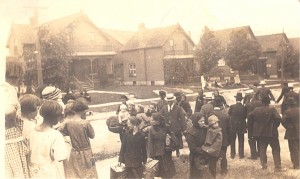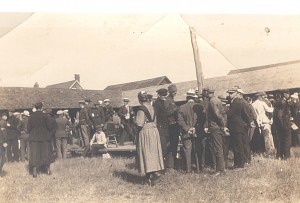The following text was taken from the book: The Leamington United Mennonite Church with permission from Henry Driedger, son of the author N.N. Driedger, author of the book. Thanks go to Conrad Grebel College Archives for providing us with the pictures.
Part 1
Toward the evening of July 17, 1924, at Quebec city, about 1000 Russian Mennonites disembarked from the C.P.R. ocean steamer “Minnedosa”. With few exceptions all those aboard had originated in the Molotschna settlement in the Halbstadt jurisdiction. On July 18, two trains of immigrants, one following the other, left Quebec for Waterloo. Even though the train they were on was a CN train the CPR company gave the CN company permission to use their tracks in order that the passengers might disembark close to their ultimate destination. The following picture shows the immigrants meeting their hosts in Waterloo. The immigrants were assigned where they were to stay for the present and, as well in some cases, might be offered work to do on a farm until they would find a permanent home.

The following text was taken from the book: Worship At St. George Street with permission from the author Karl Dick:
The first train arrived on July 19 around 1:00 in the afternoon (the second arrived about an hour and a half later), stopping at the intersection of the tracks with Erb and Caroline Streets. From there, the immigrants completed the last leg of their four-week journey on foot. Clutching small children and personal effects, they walked several blocks west along Erb Street. Curious bystanders lined Erb Street, which was in the process of being paved for the first time and was a mess, with piles of rubble strewn about. They walked to the parking lot of the Erb Street Mennonite Church where a large throng had gathered to welcome the “Russi Leit” and to take them to their homes.
Many of the immigrants have since told how they remember feeling the stares and scrutiny of the onlookers that day. The immigrants’ clothing certainly was different, and quite a few, both males and females, had their hair cut close to the scalp as a precaution against head lice. Apparently, the press was expecting the arrivals to match their preconception of European immigrants as categorically filthy.
Surprise was expressed when this proved not to be the case. Some of the local Mennonites were similarly surprised. There were other, more favourable newspaper stories as well, pointing out, for example, that while English was not one of them, these travellers were fluent in two languages (and the reporter could easily have found more than a few who had the command of three or four languages). After the second train arrived, all assembled for a short but emotional worship service led by two ministers who had come with the immigrants, Jacob Wiens and Jacob P. Friesen. Gratitude was expressed to God for their safe deliverance and to their Canadian hosts for the reception.

In 1974, Herb Enns penned a wry memory of having to wait in the Erb Street Mennonite horse sheds, rather than in the church sanctuary, because the leaders weren’t at all sure what type of people we were! There was much dejection at first – being separated from one’s relatives and “farmed out” all over Waterloo County seemed like the final straw to the immigrant families. Annie Dick Konrad wrote in 1992 of the experience: “I remember we sat in one of the horse-and-buggy stalls and watched one family after another follow their hosts to the buggy or car. I sensed the uneasiness in my parents as the evening came upon us and we were still sitting there. I snuggled close to my father and wondered, will there be no place for us?” Host families were scattered all over the countryside … at the Bishop Snider farmstead, Jonas and Susannah hosted Marie and Peter Enns’s family of five, and Jonas’ son Walter hosted Anna and Herman Enns’s family of four. Herbert Enns, son of Marie and Peter, provided a translation of this letter that his mother wrote to her sister in 1924: “Living quarters, fuel, and, for the most part, food, is supplied to us. Our hosts are very friendly and helpful; they will ask, ‘Are you in need of potatoes, lard, eggs, etc.’ and if we need anything immediately it is brought to us. I have already put away 9 dozen of eggs for the winter. Fruits and vegetables there is no end of. I have filled 60 jars of preserves and fruit… The husband of the family for whom my Peter works, is a bishop. We refer to them as Grandpa and Grandma Snider. They have offered to give us a pig for butchering, later this fall … When we arrived here, everything was ready for us; … we were speechless, unable to express our feelings. It raised our emotions to the point of breaking, as we realized how concerned our hosts had been in supplying everything in such detail.”
First-hand accounts of the relations between Waterloo County Mennonites and the Russltinder lean mainly towards positive and warm memories. Some cultural differences, in categories such as food and language, for example, were usually sources of curiosity and amusement rather than tension. However, other dissimilarities produced plenty of rough spots. Instances have been told of in which individuals of one group passed thoughtless and unkind remarks and judgements towards those of the other group. At times feelings were hurt and tempers flared. In a few cases, sufficient hostility built up to induce an immigrant family to leave their host farm after only a few weeks. [Historian Frank Epp has pointed out that tensions were likely aggravated by the sharing of close quarters.]
Some Waterloo County Mennonites at times hinted that as a group the immigrants from Russia possessed a weak work ethic, worldly modes, and a degree of arrogance. For their part, some immigrants apparently thought the Waterloo Mennonites to be a bit dull and unprogressive – even backwards. At the root of many of these perceptions were genuine cultural differences. Mennonites in the Ukraine were often educated beyond grade school, and many were versed in the arts. The indigenous Mennonites of the same era did not push for higher education unless it was framed in a church context, and secular culture was generally avoided. Those Mennonite families who were landholders in Russia tended not to work the land themselves, while most Ontario Mennonites in the 1920s were farmers. Many Mennonites in Ukraine were industrialists and entrepreneurs, while their hosts in Ontario tended to steer clear of employment in the cities … Also, in the somewhat fundamentalist atmosphere of the Ontario church, the differences in dress were very apparent.
Victor Dyck sometimes told of the adjustments he needed to make in 1929 when he was boarded out to the Webers on King St. North near today’s Home Depot. As a 17 -year-old teenager who had grown up in the very cosmopolitan city of Berdjansk, the son of a German-trained physician who operated his own clinic with a staff of several Ontario Mennonites who took in refugee families. . .. As much as the host families gave of themselves in 1924, they received at least an equal measure in return from their guests. One small example, but one recounted by several Ontario Mennonites, was the immigrants’ Christmas celebrations in the homes of their hosts. For the locals, this included enchanting Christmas trees (a first for the hosts), the singing of new songs, and exotic new foods.” N. N. Driedger remembers what a great relief it was to the Waterloo Swiss Mennonites that the Russian Mennonites spoke German, that they acknowledged God, and that they appeared clean and decent. The Driedger’s host family, the Henry Bowmans of Waterloo, lived west of Waterloo; when the Bowman grandfather was introduced to their guests, he apparently looked Nick over from top to bottom, and then pronounced in a friendly manner, “Well, this man will be a good worker.” By Driedger’s reckoning, there was only one relatively negative incident at the July 19 ceremonies in Waterloo. An older Erb Street Church member took offence at the moustache of our Rev. Jacob Wiens, who had been designated to respond to Ira Bowman’s welcoming speech. (Most of our men had come to Canada with a moustache but no beard, and to the Old Mennonites such a practice was an indication of pride. We soon, however, adopted the Canadian mode of being clean-shaven.) Justina (Dick) Dyck remembered how odd it seemed to them at the time that so many German Bibles Were readily made available by their host families.Theyhad names in them such as Noah Weber, Jeremiah Schneider, etc. (She eventually realized that the Swiss Mennonites had just made the transition to English, and were no longer using their old bibles).”They were even in ‘gothic’ (fracture) printing,” she added.
